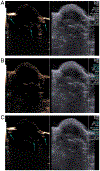Breast Cancer Brain Metastasis Response to Radiation After Microbubble Oxygen Delivery in a Murine Model
- PMID: 31124171
- PMCID: PMC7064157
- DOI: 10.1002/jum.15031
Breast Cancer Brain Metastasis Response to Radiation After Microbubble Oxygen Delivery in a Murine Model
Abstract
Objectives: Hypoxic cancer cells have been shown to be more resistant to radiation therapy than normoxic cells. Hence, this study investigated whether ultrasound (US)-induced rupture of oxygen-carrying microbubbles (MBs) would enhance the response of breast cancer metastases to radiation.
Methods: Nude mice (n = 15) received stereotactic injections of brain-seeking MDA-MB-231 breast cancer cells into the right hemisphere. Animals were randomly assigned into 1 of 5 treatment groups: no intervention, 10 Gy radiation using a small-animal radiation research platform, nitrogen-carrying MBs combined with US-mediated MB rupture immediately before 10 Gy radiation, oxygen-carrying MBs immediately before 10 Gy radiation, and oxygen-carrying MBs with US-mediated MB rupture immediately before 10 Gy radiation. Tumor progression was monitored with 3-dimensional US, and overall survival was noted.
Results: All groups except those treated with oxygen-carrying MB rupture and radiation had continued rapid tumor growth after treatment. Tumors treated with radiation alone showed a mean increase in volume ± SD of 337% ± 214% during the week after treatment. Tumors treated with oxygen-carrying MBs and radiation without MB rupture showed an increase in volume of 383% ± 226%. Tumors treated with radiation immediately after rupture of oxygen-carrying MBs showed an increase in volume of only 41% ± 1% (P = 0.045), and this group also showed a 1 week increase in survival time.
Conclusions: Adding US-ruptured oxygen-carrying MBs to radiation therapy appears to delay tumor progression and improve survival in a murine model of metastatic breast cancer.
Keywords: contrast-enhanced ultrasound; hypoxia; oxygen delivery; radiosensitivity.
© 2019 by the American Institute of Ultrasound in Medicine.
Figures




Similar articles
-
Sensitization of Hypoxic Tumors to Radiation Therapy Using Ultrasound-Sensitive Oxygen Microbubbles.Int J Radiat Oncol Biol Phys. 2018 May 1;101(1):88-96. doi: 10.1016/j.ijrobp.2018.01.042. Epub 2018 Jan 31. Int J Radiat Oncol Biol Phys. 2018. PMID: 29477294 Free PMC article.
-
Half brain irradiation in a murine model of breast cancer brain metastasis: magnetic resonance imaging and histological assessments of dose-response.Radiat Oncol. 2018 Jun 1;13(1):104. doi: 10.1186/s13014-018-1028-8. Radiat Oncol. 2018. PMID: 29859114 Free PMC article.
-
A Robust Oxygen Microbubble Radiosensitizer for Iodine-125 Brachytherapy.Adv Sci (Weinh). 2021 Feb 10;8(7):2002567. doi: 10.1002/advs.202002567. eCollection 2021 Apr. Adv Sci (Weinh). 2021. PMID: 33854878 Free PMC article.
-
Parathyroid hormone-related protein and bone metastases.Cancer. 1997 Oct 15;80(8 Suppl):1572-80. doi: 10.1002/(sici)1097-0142(19971015)80:8+<1572::aid-cncr7>3.3.co;2-d. Cancer. 1997. PMID: 9362424 Review.
-
Microbubble Delivery Platform for Ultrasound-Mediated Therapy in Brain Cancers.Pharmaceutics. 2023 Feb 19;15(2):698. doi: 10.3390/pharmaceutics15020698. Pharmaceutics. 2023. PMID: 36840020 Free PMC article. Review.
Cited by
-
Innate Immune System in the Context of Radiation Therapy for Cancer.Cancers (Basel). 2023 Aug 4;15(15):3972. doi: 10.3390/cancers15153972. Cancers (Basel). 2023. PMID: 37568788 Free PMC article. Review.
-
Breast cancer brain metastasis: insight into molecular mechanisms and therapeutic strategies.Br J Cancer. 2021 Oct;125(8):1056-1067. doi: 10.1038/s41416-021-01424-8. Epub 2021 Jul 5. Br J Cancer. 2021. PMID: 34226684 Free PMC article. Review.
-
Improved Tumor Control Following Radiosensitization with Ultrasound-Sensitive Oxygen Microbubbles and Tumor Mitochondrial Respiration Inhibitors in a Preclinical Model of Head and Neck Cancer.Pharmaceutics. 2023 Apr 21;15(4):1302. doi: 10.3390/pharmaceutics15041302. Pharmaceutics. 2023. PMID: 37111787 Free PMC article.
-
Radiotherapy in Preclinical Models of Brain Metastases: A Review and Recommendations for Future Studies.Int J Biol Sci. 2024 Jan 1;20(2):765-783. doi: 10.7150/ijbs.91295. eCollection 2024. Int J Biol Sci. 2024. PMID: 38169621 Free PMC article. Review.
-
Tumoral oxygenation and biodistribution of Lonidamine oxygen microbubbles following localized ultrasound-triggered delivery.Int J Pharm. 2022 Sep 25;625:122072. doi: 10.1016/j.ijpharm.2022.122072. Epub 2022 Aug 3. Int J Pharm. 2022. PMID: 35932933 Free PMC article.
References
-
- Siegel RL, Miller KD, Jemal A. Cancer statistics, 2016. CA Cancer J Clin 2016; 66:7–30. - PubMed
-
- Lin NU, Bellon JR, Winer EP. CNS metastases in breast cancer. J Clin Oncol 2004; 22:3608–3617. - PubMed
-
- Folkman J Role of angiogenesis in tumor growth and metastasis. Semin Oncol 2002; 29:15–18. - PubMed
-
- Weidner N, Semple JP, Welch WR, Folkman J. Tumor angiogenesis and metastasis: correlation in invasive breast carcinoma. N Engl J Med 1991; 324:1–8. - PubMed
-
- Zetter BR Angiogenesis and tumor metastasis. Annu Rev Med 1998; 49:407–424. - PubMed
MeSH terms
Substances
Grants and funding
LinkOut - more resources
Full Text Sources
Medical
Miscellaneous

